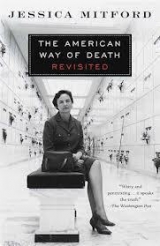
Текст книги "The American Way of Death Revisited"
Автор книги: Jessica Mitford
сообщить о нарушении
Текущая страница: 5 (всего у книги 23 страниц)
5. THE STORY OF SERVICE
There was a time when the undertaker’s tasks were clear-cut and rather obvious, and when he billed his patrons accordingly. Typical late-nineteenth-century charges, in addition to the price of merchandise, are shown on bills of the period as: “Services at the house (placing corpse in the coffin), $1.25,” “Preserving remains on ice, $10,” “Getting permit, $1.50.” It was customary for the undertaker to add a few dollars to his bill for being “in attendance,” which seems only fair and right. The cost of embalming was around $10 in 1880. An undertaker, writing in 1900, recommends these minimums for service charges: washing and dressing, $5; embalming, $10; hearse, $8 to $10. As Robert W. Habenstein and William M. Lamers, the historians of the trade, have pointed out, “The undertaker had yet to conceive of the value of personal service offered professionally for a fee, legitimately claimed.” Well, he has now so conceived with a vengeance.
When weaving in the story of service as it is rendered today, spokesmen for the funeral industry tend to become so carried away by their own enthusiasm, so positively lyrical and copious in their declarations, that the outsider may have a little trouble understanding it all. There are indeed contradictions. Preferred Funeral Directors International has prepared a talk designed to inform people about service: “The American public receive the services of employees and proprietor alike, nine and one half days of labor for every funeral handled, they receive the use of automobiles and hearses, a building including a chapel and other rooms which require building maintenance, insurance, taxes and licenses, and depreciation, as well as heat in the winter, cooling in the summer, light and water.” The writer goes on to say that while the process of embalming takes only about three hours, “it would be necessary for one man to work two forty-hour weeks to complete a funeral service. This is coupled with an additional forty hours of service required by members of other local allied professions, including the work of the cemeteries, newspapers, and, of course, the most important of all, the service of your clergyman. These some 120 hours of labor are the basic value on which the cost of funerals rests.”
Our informant has lumped a lot of things together here. To start with “the most important of all, the service of your clergyman”: the average religious funeral service lasts no more than twenty-five minutes. Furthermore, it is not, of course, paid for by the funeral director. The “work of the cemeteries” presumably means the opening and closing of a grave. This now mechanized operation, which takes fifteen to twenty minutes, is likewise not billed as part of the funeral director’s costs. The work of “newspapers”? This is a puzzler. Presumably, reference is made here to the publication of an obituary notice on the vital statistics page. It is, incidentally, surprising to learn that newspaper work is considered an “allied profession.”
Just how insurance, taxes, licenses, and depreciation are figured in as part of the 120 man-hours of service is hard to tell. The writer does mention that his operation features “65 items of service.” In general, the funeral salesman is inclined to chuck in everything he does under the heading of “service.” For example, in a typical list of “services” he will include items like “securing statistical data” (in other words, completing the death certificate and finding out how much insurance was left by the deceased), the “arrangements conference” (in which the sale of the funeral to the survivors is made), and the “keeping of records,” by which he means his own bookkeeping work. Evidently, there is some confusion here between items that properly belong in a cost-accounting system and items of actual service rendered in any given funeral. In all likelihood, the idle time of employees is figured in and prorated as part of the “man-hours.” The up-to-date funeral home operates on a twenty-four-hour basis, and the prepared speech contains this heartening news:
The funeral service profession of the United States is proud of the fact that there is not a person within the continental limits of the United States who is more than two hours away from a licensed funeral director and embalmer. That’s one that even the fire-fighting apparatus of our country cannot match.
While the hit-or-miss rhetoric of the foregoing is fairly typical of the prose style of the funeral trade as a whole, and while the statement that 120 man-hours are devoted to a single funeral may be open to question, there really is a fantastic amount of service accorded the dead body and its survivors.
Having decreed what sort of funeral is right, proper, and nice, and having gradually appropriated to himself all the functions connected with it, the funeral director has become responsible for a multitude of tasks—beyond the obvious one of “placing corpse in the coffin” recorded in our nineteenth-century funeral bill. His self-imposed duties fall into two main categories: attention to the corpse itself, and the stage-managing of the funeral.
The drama begins to unfold with the arrival of the corpse at the mortuary.
Alas, poor Yorick! How surprised he would be to see how his counterpart of today is whisked off to a funeral parlor and is in short order sprayed, sliced, pierced, pickled, trussed, trimmed, creamed, waxed, painted, rouged, and neatly dressed—transformed from a common corpse into a Beautiful Memory Picture. This process is known in the trade as embalming and restorative art, and is so universally employed in the United States and Canada that for years the funeral director did it routinely, without consulting corpse or kin. He regards as eccentric those few who are hardy enough to suggest that it might be dispensed with. Yet no law requires embalming, no religious doctrine commends it, nor is it dictated by considerations of health, sanitation, or even of personal daintiness. In no part of the world but in North America is it widely used. The purpose of embalming is to make the corpse presentable for viewing in a suitably costly container; and here too the funeral director routinely, without first consulting the family, prepares the body for public display.
Is all this legal? The processes to which a dead body may be subjected are, after all, to some extent circumscribed by law. In most states, for instance, the signature of next of kin must be obtained before an autopsy may be performed, before the deceased may be cremated, before the body may be turned over to a medical school for research purposes; or such provision must be made in the decedent’s will. In the case of embalming, permission is required (under Federal Trade Commission rules) only if a charge is to be made for the procedure. Embalming is not, as funeral providers habitually claim, a legal requirement even when the body of the deceased is to be on display in an open casket. A textbook, The Principles and Practices of Embalming, comments on this: “There is some question regarding the legality of much that is done within the preparation room.” The author points out that it would be most unusual for a responsible member of a bereaved family to instruct the mortician, in so many words, to “embalm” the body of a deceased relative. The very term “embalming” is so seldom used that the mortician must rely upon custom in the matter. The author concludes that unless the family specifies otherwise, the act of entrusting the body to the care of a funeral establishment carries with it an implied permission to go ahead and embalm.
Embalming is indeed a most extraordinary procedure, and one must wonder at the docility of Americans who each year pay hundreds of millions of dollars for its perpetuation, blissfully ignorant of what it is all about, what is done, and how it is done. Not one in ten thousand has any idea of what actually takes place. Books on the subject are extremely hard to come by. You will not find them in your neighborhood bookshop or library.
In an era when huge television audiences watch surgical operations in the comfort of their living rooms, when, thanks to the animated cartoon, the geography of the digestive system has become familiar territory even to the nursery-school set, in a land where the satisfaction of curiosity about almost all matters is a national pastime, surely the secrecy surrounding embalming cannot be attributed to the inherent gruesomeness of the subject. Custom in this regard has within this century suffered a complete reversal. In the early days of American embalming, when it was performed in the home of the deceased, it was almost mandatory for some relative to stay by the embalmer’s side and witness the procedure. Today, family members who might wish to be in attendance would certainly be dissuaded by the funeral director. All others, except apprentices, are usually barred by law from the preparation room.
A close look at what actually does take place may explain in large measure the undertaker’s intractable reticence concerning a procedure that has become his major raison d’être. Is it possible he fears that public information about embalming might lead patrons to wonder if they really want this service? If the funeral men are loath to discuss the subject outside the trade, the reader may, understandably, be equally loath to go on reading at this point. For those who have the stomach for it, let us part the formaldehyde curtain. Others should skip to the bottom of this page.
The body is first laid out in the undertaker’s morgue—or, rather, Mr. Jones is reposing in the preparation room to be readied to bid the world farewell.
The preparation room in any of the better funeral establishments has the tiled and sterile look of a surgery, and indeed the embalmer/restorative artist who does his chores there is beginning to adopt the term “dermasurgeon” (appropriately corrupted by some mortician-writers as “demi-surgeon”) to describe his calling. His equipment—consisting of scalpels, scissors, augers, forceps, clamps, needles, pumps, tubes, bowls, and basins—is crudely imitative of the surgeon’s, as is his technique, acquired in a nine– or twelve-month post-high school course at an embalming school. He is supplied by an advanced chemical industry with a bewildering array of fluids, sprays, pastes, oils, powders, creams, to fix or soften tissue, shrink or distend it as needed, dry it here, restore the moisture there. There are cosmetics, waxes, and paints to fill and cover features, even plaster of Paris to replace entire limbs. There are ingenious aids to prop and stabilize the cadaver: a VariPose Head Rest, the Edwards Arm and Hand Positioner, the Repose Block (to support the shoulders during the embalming), and the Throop Foot Positioner, which resembles an old-fashioned stocks.
Mr. John H. Eckels, president of the Eckels College of Mortuary Science, thus describes the first part of the embalming procedure: “In the hands of a skilled practitioner, this work may be done in a comparative short time and without mutilating the body other than by slight incision so slight that it scarcely would cause serious inconvenience if made upon a living person. It is necessary to remove the blood, and doing this not only helps in the disinfecting, but removes the principal cause of disfigurements due to discoloration.”
Another textbook discusses the all-important time element: “The earlier this is done, the better, for every hour that elapses between death and embalming will add to the problems and complications encountered….” Just how soon should one get going on the embalming? The author tells us, “On the basis of such scanty information made available to this profession through its rudimentary and haphazard system of technical research, we must conclude that the best results are to be obtained if the subject is embalmed before life is completely extinct—that is, before cellular death has occurred. In the average case, this would mean within an hour after somatic death.” For those who feel that there is something a little rudimentary, not to say haphazard, about this advice, a comforting thought is offered by another writer. “Speaking of fears entertained in the early days of premature burial,” he points out, “one of the effects of embalming by chemical injection, however, has been to dispel fears of live burial.” How true; once the blood is removed, chances of live burial are indeed remote.
To return to Mr. Jones, the blood is drained out through the veins and replaced by embalming fluid pumped in through the arteries. As noted in The Principles and Practices of Embalming, “Every operator has a favorite injection and drainage point—a fact which becomes a handicap only if he fails or refuses to forsake his favorites when conditions demand it.” Typical favorites are the carotid artery, femoral artery, jugular vein, and subclavian vein. There are various choices of embalming fluid. If Flextone is used, it will produce a “mild, flexible rigidity. The skin retains a velvety softness, the tissues are rubbery and pliable. Ideal for women and children.” It may be blended with B. and G. Products Company’s Lyf-Lyk tint, which is guaranteed to reproduce “nature’s own skin texture… the velvety appearance of living tissue.” Suntone comes in three separate tints: Suntan; Special Cosmetic Tint; moderately pink.
About three to six gallons of a dyed and perfumed solution of formaldehyde, glycerin, borax, phenol, alcohol, and water is soon circulating through Mr. Jones, whose mouth has been sewn together with a “needle directed upward between the upper lip and gum and brought out through the left nostril,” with the corners raised slightly “for a more pleasant expression.” If he should be buck-toothed, his teeth are cleaned with Bon Ami and coated with colorless nail polish. His eyes, meanwhile, are closed with flesh-tinted eye caps and eye cement.
The next step is to have at Mr. Jones with a thing called a trocar. This is a long, hollow needle attached to a tube. It is jabbed into the abdomen and poked around the entrails and chest cavity, the contents of which are pumped out and replaced with “cavity fluid.” This done, and the hole in the abdomen having been sewn up, Mr. Jones’s face is heavily creamed (to protect the skin from burns which may be caused by leakage of the chemicals), and he is covered with a sheet and left unmolested for a while. But not for long—there is more, much more, in store for him. He has been embalmed, but not yet restored, and the best time to start the restorative work is eight to ten hours after embalming, when the tissues have become firm and dry.
The object of all this attention to the corpse, it must be remembered, is to make it presentable for viewing in an attitude of healthy repose. “Our customs require the presentation of our dead in the semblance of normality… unmarred by the ravages of illness, disease or mutilation,” says Mr. J. Sheridan Mayer in his Restorative Art. This is rather a large order since few people die in the full bloom of health, unravaged by illness and unmarked by some disfigurement. The funeral industry is equal to the challenge: “In some cases the gruesome appearance of a mutilated or disease-ridden subject may be quite discouraging. The task of restoration may seem impossible and shake the confidence of the embalmer. This is the time for intestinal fortitude and determination. Once the formative work is begun and affected tissues are cleaned or removed, all doubts of success vanish. It is surprising and gratifying to discover the results which may be obtained.”
The embalmer, having allowed an appropriate interval to elapse, returns to the attack, but now brings into play the skill and equipment of sculptor and cosmetician. Is a hand missing? Casting one in plaster of Paris is a simple matter. “For replacement purposes, only a cast of the back of the hand is necessary; this is within the ability of the average operator and is quite adequate.” If a lip or two, a nose, or an ear should be missing, the embalmer has at hand a variety of restorative waxes with which to model replacements. Pores and skin texture are simulated by stippling with a little brush, and over this cosmetics are laid on. Head off? Decapitation cases are rather routinely handled. Ragged edges are trimmed, and head joined to torso with a series of splints, wires, and sutures. It is a good idea to have a little something at the neck—a scarf or high collar—when time for viewing comes. Swollen mouth? Cut out tissue as needed from inside the lips. If too much is removed, the surface contour can easily be restored by padding with cotton. Swollen neck and cheeks are reduced by removing tissue through vertical incisions made down each side of the neck. “When the deceased is casketed, the pillow will hide the suture incisions…. [A]s an extra precaution against leakage, the suture may be painted with liquid sealer.”
The opposite condition is more likely to present itself—that of emaciation. His hypodermic syringe now loaded with massage cream, the embalmer seeks out and fills the hollowed and sunken areas by injection. In this procedure, the backs of the hands and fingers and the under-chin area should not be neglected.
Positioning the lips is a problem that recurrently challenges the ingenuity of the embalmer. Closed too tightly, they tend to give a stern, even disapproving expression. Ideally, embalmers feel, the lips should give the impression of being ever so slightly parted, the upper lip protruding slightly for a more youthful appearance. This takes some engineering, however, as the lips tend to drift apart. Lip drift can sometimes be remedied by pushing one or two straight pins through the inner margin of the lower lip and then inserting them between the two front upper teeth. If Mr. Jones happens to have no teeth, the pins can just as easily be anchored in his Armstrong Face Former and Denture Replacer. Another method to maintain lip closure is to dislocate the lower jaw, which is then held in its new position by wire run through holes which have been drilled through the upper and lower jaws at the midline. As the French are fond of saying, il faut souffrir pour être belle.
If Mr. Jones has died of jaundice, the embalming fluid will very likely turn green. Does this deter the embalmer? Not if he has intestinal fortitude. Masking pastes and cosmetics are heavily laid on, burial garments and casket interiors are color-correlated with particular care, and Jones is displayed beneath rose-colored lights. Friends will say, “How wellhe looks.” Death by carbon monoxide, on the other hand, can be rather a good thing from the embalmer’s viewpoint: “One advantage is the fact that this type of discoloration is an exaggerated form of a natural pink coloration.” This is nice because the healthy glow is already present and needs but little attention.
The patching and filling completed, Mr. Jones is now shaved, washed, and dressed. A cream-based cosmetic, available in pink, flesh, suntan, brunette, and blond, is applied to his hands and face, his hair is shampooed and combed (and, in the case of Mrs. Jones, set), his hands manicured. For the horny-handed son of toil, special care must be taken; cream should be applied to remove ingrained grime, and the nails cleaned. “If he were not in the habit of having them manicured in life, trimming and shaping is advised for better appearance—never questioned by kin.”
Jones is now ready for casketing (this is the present participle of the verb “to casket”). In this operation his right shoulder should be depressed slightly “to turn the body a bit to the right and soften the appearance of lying flat on the back.” Positioning the hands is a matter of importance, and special rubber positioning blocks may be used. The hands should be cupped slightly for a more lifelike, relaxed appearance. Proper placement of the body requires a delicate sense of balance. It should lie as high as possible in the casket, yet not so high that the lid, when lowered, will hit the nose. On the other hand, we are cautioned, placing the body too low “creates the impression that the body is in a box.”
Jones is next wheeled into the appointed slumber room, where a few last touches may be added—his favorite pipe placed in his hand, or, if he was a great reader, a book propped into position. (In the case of little Master Jones, a teddy bear may be clutched.) Here he will hold open house for a few days, visiting hours 10 a.m. to 5 p.m.
All now being in readiness, the funeral director calls a staff conference to make sure that each assistant knows his precise duties. Mr. Wilber Krieger writes: “This makes your staff feel that they are a part of the team, with a definite assignment that must be properly carried out if the whole plan is to succeed. You never heard of a football coach who failed to talk to his entire team before they go on the field. They have been drilled on the plays they are to execute for hours and days, and yet the successful coach knows the importance of making even the bench-warming third-string substitute feel that he is important if the game is to be won.” The winning of thisgame is predicated upon a glass-smooth handling of the logistics. The funeral director has notified the pallbearers, whose names were furnished by the family, has arranged for the presence of a clergyman, organist, and soloist, has provided transportation for everybody, has organized and listed the flowers sent by friends. In Psychology of Funeral Service, Mr. Edward A. Martin points out: “He may not always do as much as the family thinks he is doing, but it is his helpful guidance that they appreciate in knowing they are proceeding as they should…. The important thing is how well his services can be used to make the family believe they are giving unlimited expression to their own sentiment.”
The religious service may be held in a church or in the chapel of the funeral home; the funeral director vastly prefers the latter arrangement, for not only is it more convenient for him, but it affords him the opportunity to show off his beautiful facilities to the gathered mourners. After the clergyman has had his say, the mourners queue up to file past the casket for a last look at the deceased. The family is not asked whether they want an open-casket ceremony; in the absence of instruction to the contrary, this is taken for granted. Consequently, well over 68 percent of all American funerals in the mid-1990s featured an open casket—a custom unknown in other parts of the world. Foreigners are astonished by it. An Englishwoman living in San Francisco described her reaction in a letter to the writer:
I myself have attended only one funeral here—that of an elderly fellow worker of mine. After the service I could not understand why everyone was walking towards the coffin (sorry, I mean casket), but thought I had better follow the crowd. It shook me rigid to get there and find the casket open and poor old Oscar lying there in his brown tweed suit, wearing a suntan makeup and just the wrong shade of lipstick. If I had not been extremely fond of the old boy, I have a horrible feeling that I might have giggled. Then and there I decided that I could never face another American funeral—even dead.
The casket (which has been resting throughout the service on a Classic Beauty Ultra Metal Casket Bier) is now transferred by a hydraulically operated device called Porto-Lift to a balloon-tired, Glide Easy casket carriage which will wheel it to yet another conveyance, the Cadillac Funeral Coach. This may be lavender, cream, light green. Black, once de rigueur, is coming back into fashion. Interiors, of course, are color-correlated, “for the man who cannot stop short of perfection.”
At graveside, the casket is lowered into the earth. This office, once the prerogative of friends of the deceased, is now performed by a patented mechanical lowering device. A “Lifetime Green” artificial grass mat is at the ready to conceal the sere earth, and overhead, to conceal the sky, is a portable Steril Chapel Tent (“resists the intense heat and humidity of summer and the terrific storms of winter… available in Silver Grey, Rose or Evergreen”). Now is the time for the ritual scattering of the earth over the coffin, as the solemn words “earth to earth, ashes to ashes, dust to dust” are pronounced by the officiating cleric. This can today be accomplished “with a mere flick of the wrist with the Gordon Leak-Proof Earth Dispenser. No grasping of a handful of dirt, no soiled fingers. Simple, dignified, beautiful, reverent! The modern way!” The Gordon Earth Dispenser is of nickel-plated brass construction. It is not only “attractive to the eye and long wearing”; it is also “one of the ‘tools’ for building better public relations” if presented as “an appropriate non-commercial gift” to the clergy. It is shaped something like a saltshaker.
Untouched by human hand, the coffin and the earth are now united.
It is in the function of directing the participants through this maze of gadgetry that the funeral director has assigned to himself his relatively new role of “grief therapist.” He has relieved the family of every detail, he has revamped the corpse to look like a living doll, he has arranged for it to nap for a few days in a slumber room, he has put on a well-oiled performance in which the concept of deathhas played no part whatsoever—unless it was inconsiderately mentioned by the clergyman who conducted the religious service. He has done everything in his power to make the funeral a real pleasure for everybody concerned. He and his team have given their all to score an upset victory over death.
Dale Carnegie has written that in the lexicon of the successful man there is no such word as “failure.” So have the undertakers managed to delete the word “death” and all its associations from their vocabulary. They have from time to time published lists of In and Out words and phrases to be memorized and used in connection with the final return of dust to dust; then, still dissatisfied with the result, they have elaborated and revised the list. Thus, a 1916 glossary substitutes “prepare body” for “handle corpse.” Today, though, “body” is Out and “remains” or “Mr. Jones” is In.
“The use of improper terminology by anyone affiliated with a mortuary should be strictly forbidden,” declares Edward A. Martin. He suggests a rather thorough overhauling of the language; his deathless words include: “service, not funeral; Mr., Mrs., Miss blank, not corpse or body; preparation room, not morgue; casket, not coffin; funeral director or mortician, not undertaker; reposing room, not showroom; baby or infant, not stillborn; deceased, not dead; autopsy or post-mortem, not ‘post’; coach, not hearse; shipping case, not shipping box; flower car, not flower truck; cremains or cremated remains, not ashes; clothing, dress, suit, etc., not shroud; drawing room, not parlor.”
This rather basic list was refined in 1956 by Victor Landig in his Basic Principles of Funeral Service. He enjoins the reader to avoid using the word “death” as much as possible, even when such avoidance may seem impossible; for example, a death certificate should be referred to as a “vital statistics form.” One should speak not of the “job” but rather of the “call.” We do not “haul” a dead person, we “transfer” or “remove” him—and we do this in a “service car,” not a “body car.” We “open and close” his grave rather than dig and fill it, and in it we “inter” rather than bury him. This is done not in a graveyard or cemetery, but rather in a “memorial park.” The deceased is beautified, not with makeup, but with “cosmetics.” Anyway, he didn’t die, he “expired.” An important error to guard against, cautions Mr. Landig, is referring to “cost of the casket.” The phrase “amount of investment in the service” is a wiser usage here.
Miss Anne Hamilton Franz, writing in Funeral Direction and Management, adds an interesting footnote on the use of the word “ashes” to describe (in a word) ashes. She fears this usage will encourage scattering (for what is more natural than to scatter ashes?), and prefers to speak of “cremated remains” or “human remains.” She does not like the word “retort” to describe the container in which cremation takes place, but prefers “cremation chamber” or “cremation vault,” because this “sounds better and softens any harshness to sensitive feelings.”
As for the Loved One, poor fellow, he wanders like a sad ghost through the funeral men’s pronouncements. No provision seems to have been made for the burial of a Heartily Disliked One, although the necessity for such must arise in the course of human events. [4]4
The funeral people, ever alert to fill a need, have come up with a casket that can be written on. The York “Expressions” casket, introduced at the 1996 convention of the National Funeral Directors Association, features “a smooth surface with a special coating on which those who gather may write one last farewell to the departed.” The caskets come with a set of permanent markers and a Memorial Guide that rashly invites “those who gather” to “make known their hidden thoughts.” As happens when chums are invited to autograph a schoolmate’s surgical cast, there will predictably be the occasional nonconformist who is unable to resist the temptation to use the permanent marker to express his hidden thoughts, however derogatory.
[Закрыть]








